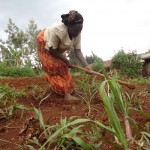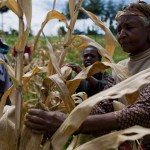This article was originally published by IMANI, a leading Ghanaian think tank. An edited version is republished here with their permission
Ghana was one of the few countries to attain the Millennium Development Goal (MDG) of halving poverty: from one in two people living below the poverty line in the early 1990s it reduced to less than one in four by 2013. The MDGs have been useful in setting the global policy framework and driving the agenda, but poverty remains a challenge and appears to be endemic amongst Ghanaians who depend on agriculture as a primary source of income.
Between 2007 and 2016 economic growth in Ghana averaged 7.1%; over the same time period growth in the agriculture sector averaged 3.5%. Analysis by the African Development Bank suggests that growth of at least 7% is necessary for poverty alleviation to occur. It is clear that for those engaged in agriculture this process is lagging behind the rest of the country. Inequitable distribution of wealth is one indicator of growing inequality in Ghana. The Gini coefficient has deteriorated from 37% in 1992 to 42.3% in 2013. The newly agreed Sustainable Development Goal 1 aims to end poverty in all its forms everywhere. In Ghana, it will be crucial to look narrowly at agriculture and how it can contribute.
The business of the poor
In 2013, the Food and Agriculture Organization of the United Nations (FAO) estimated that 54% of Ghana’s working population was employed in the agriculture sector. For the rural population in the three northern regions (Upper West, Upper East and Northern) agriculture makes up 90.1% of employment, higher than the national average in rural areas of 76.1%. Incidence of poverty is also highest in the three northern regions, with Upper West being the poorest region in the country. This suggests a strong linkage between reliance on agriculture for income and poverty in Ghana.
The majority of those who depend on agriculture for their livelihood are small-scale peasant farmers. The sector is plagued by many challenges: low levels of mechanisation and adoption of technology, dependence on rain-fed agriculture, an insecure land tenure system, a lack of interest in agriculture and low investment. There are also problems with storage and poor management of post-harvest yields. This has resulted in low yields, under-cultivation of land and a lack of value addition to agricultural produce. Given the strong linkage between poverty and agriculture, policies should be hinged on supporting a business model for agriculture that progresses from subsistence.
An agricultural advantage
Ghana has three untapped advantages when it comes to agriculture. Firstly, human capital is readily available and high levels of youth unemployment could be tackled, in part, by creating opportunities in the sector. Secondly, the FAO estimates that only 43% of Ghana’s agricultural land area is currently being cultivated. Lastly, despite the importance of irrigation to facilitate year-long farming only 303.45km2 of agricultural land in Ghana out of about 140,000 km2 was irrigated as of 2012. The Ghana Irrigation Development Policy envisages 5,000 km2 of irrigated land, but even if this target is met 96% of agricultural land will remain without any form of irrigation.
From a technical standpoint, crop yields are consistently lower than achievable yields. The gaps between actual and achievable are biggest for cash crops like cashew, pepper, maize, rice and yam. Rice meets only 38.5% of its achievable target. The Head of Rice Research and Development at the Savanna Agriculture Research Institute was recently quoted as saying that the country is able to produce only 2,000 of the 20,000 metric tons of certified seeds required annually by Ghanaian farmers. The lack of certified seeds for cultivation is cited as one of the main reasons for low yields. Scientific agriculture must be adopted into integrated development programmes.
An example of an innovative approach to address challenges in the agriculture sector is the establishment of the Ghana Commodity Exchange Project which is expected to be operational by mid-2016. This project aims to improve linkages in the agriculture value chain; and to offer guaranteed assurances of reasonable prices for farmers’ crops, reliable delivery, a trouble-free payment system, as well as storage and warehouse facilities.
An issue for voters
Political parties in Ghana recognise the importance of developing agriculture for economic prosperity and its direct links to poverty reduction. In their 2012 manifestos, the five leading political parties set out plans for how they would improve the sector. As the country heads into another election, it will be important to review and revise these plans where necessary.
In 2012, the National Democratic Congress (NDC) promised agricultural modernisation which they aimed to achieve through the expansion of a National Service Scheme (NSS). Under the scheme, NSS personnel were to educate local farmers on the application of modern methods to food production. The NDC, along with others, also emphasised the need for significant investment in the agricultural sector. For the New Patriotic Party (NPP), a key strategy for poverty alleviation was to be driven by the transformation of agriculture and the associated economic development of the three northern regions. The NPP also planned to transform the University of Development Studies in Tamale into an academic centre for excellence in agriculture and support irrigation initiatives to facilitate year-round farming.
The Convention People’s Party planned to provide accessible roads for the transportation of produce. The People’s National Convention targeted the production of food surpluses for export whilst ensuring that the people eat what they produce, the expansion of irrigation works and a railway network to aid in transportation. Finally, the Prgressive People’s Party emphasised the role for science and technology in the modernisation of agriculture. Combined with the provision of low cost loans and technical assistance these would, they argued, have the effect of pushing Ghana towards middle income status.
Manifesting change
While the agriculture sector has experienced slow growth, Ghana’s services sector has continued to expand rapidly. A report by the World Bank associates much of the growth in the other sectors of the economy to the shift away from agriculture. However, this shift may not be sustainable due to the increasing pressure urbanisation is putting on infrastructure and other social services. The majority of the people exiting agriculture are finding employment in the informal sector; putting them at risk of falling into urban poverty. Investment in agriculture is definitely not the sole means of reducing poverty, but given the nature of Ghana’s economy, the demography and topography, it could have a critical role to play.
Ghana’s agriculture potential is considerable. Given that a large share of the population is directly employed in the sector, strategic investments could have significant impact on poverty reduction and bring growth to the three northern regions in particular.
Broad agreement exists amongst political parties when it comes to supporting agricultural mechanisation in Ghana in order to commercialise the sector. In preparing their respective manifestos ahead of November’s election, they should move away from endless lists and focus instead on the answers to the questions of implementation – the how, when, who and where; and provide evidence to support how these initiatives and policies would be funded. These are the details which will differentiate one party manifesto from the rest.
Maud Martei is IMANI’s Deputy Head of Research and Sandra Kwayisi is an intern.












